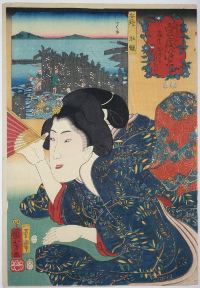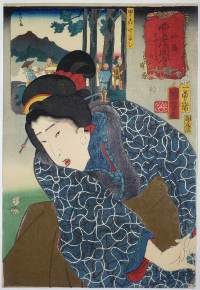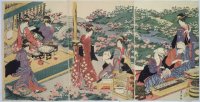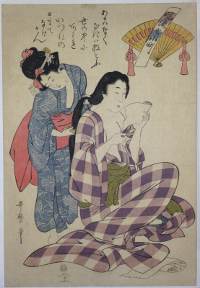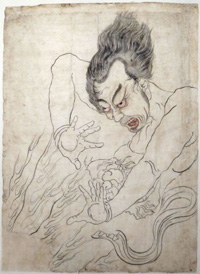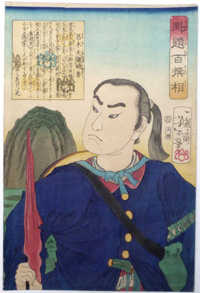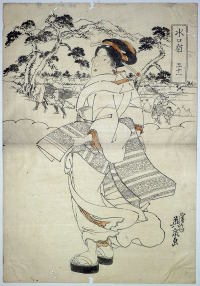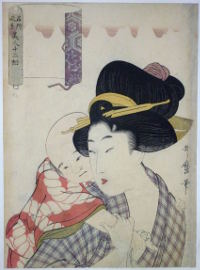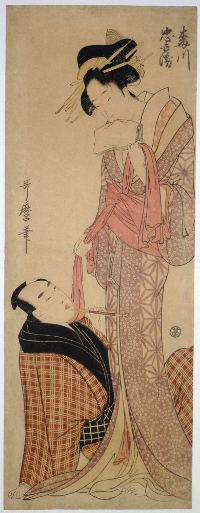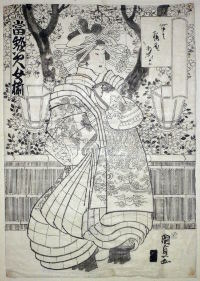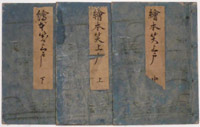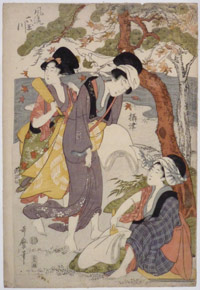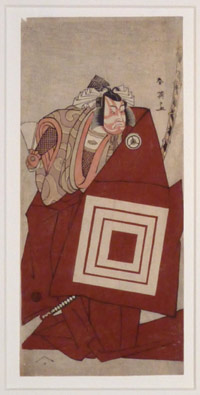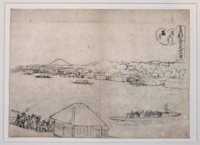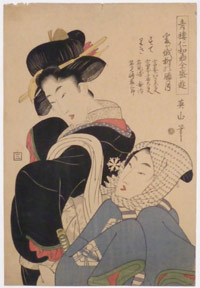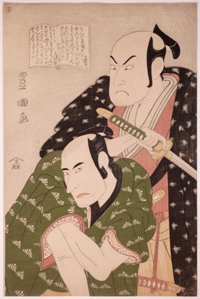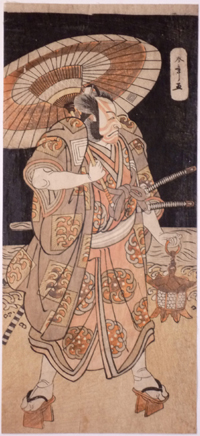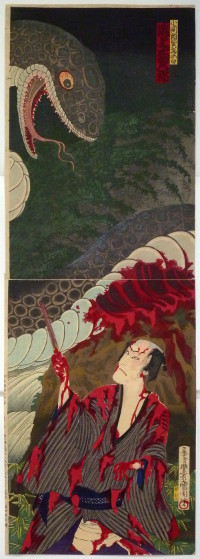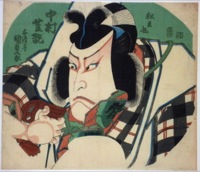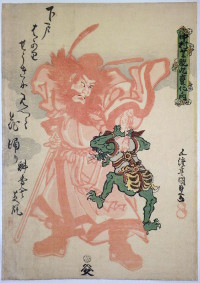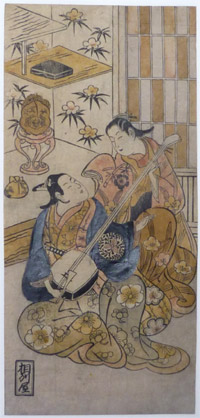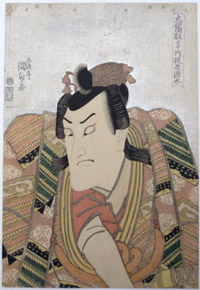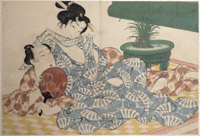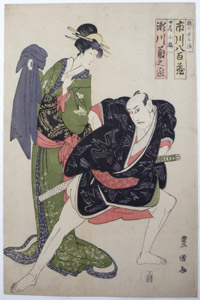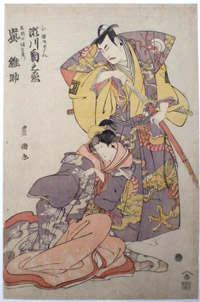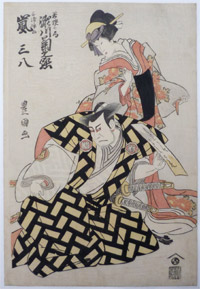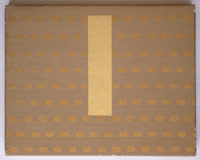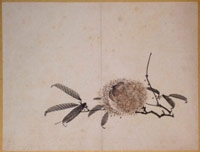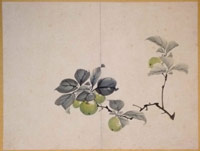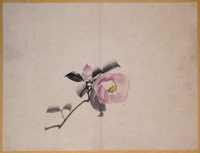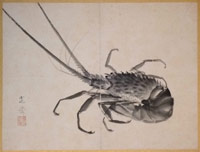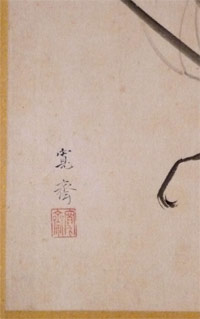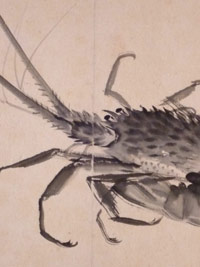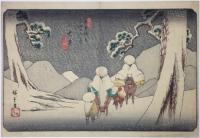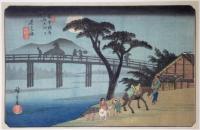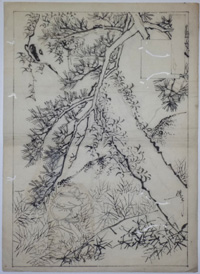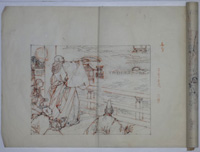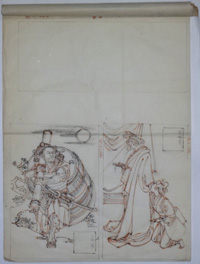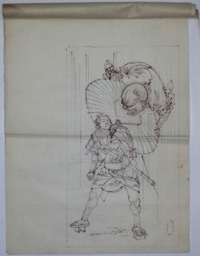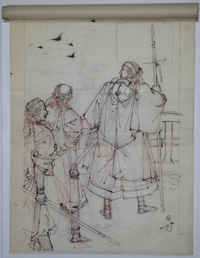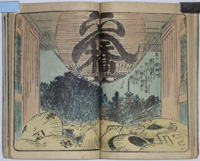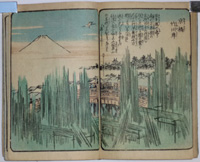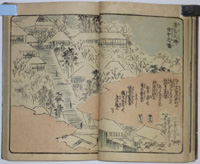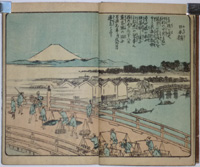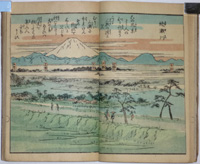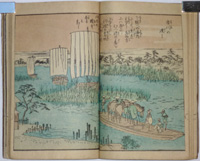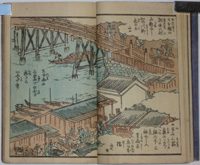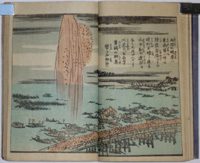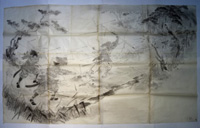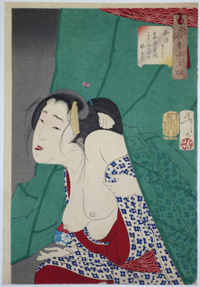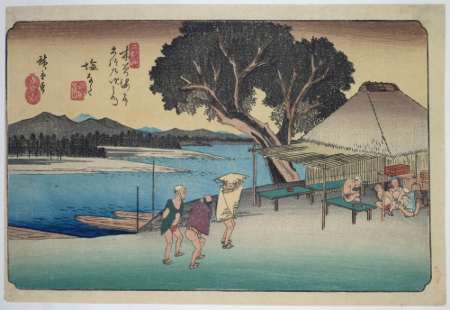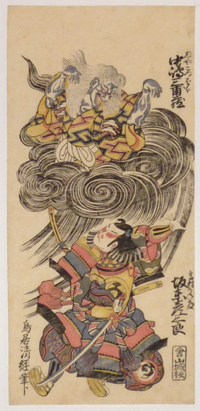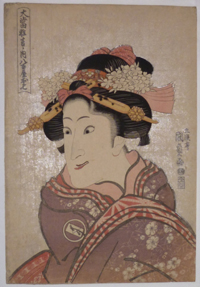/category/archive/page/54/
Utagawa KUNIYOSHI (1797-1861)
Click here to view image full size.
A beauty in sumptuous clothing from a fine set of seventy numbered prints with title: Sankai medetai zu, “Excellences of Mountain and Sea.” The set compares busts of beautiful women with various products and occupations from the provinces of Japan. The inset view here shows oyster collecting in Aki Province. The set published 1852 by Sano-ya Kihei.
Superb impression, very fine colour and condition. Signed Ichiyusai Kuniyoshi ga.
Status: Sold
Utagawa KUNIYOSHI (1797-1861)
Click here to view image full size.
A beauty in sumptuous clothing from a fine set of seventy numbered prints with title: Sankai medetai zu, “Excellences of Mountain and Sea.” The set compares busts of beautiful women with various products and occupations from the provinces of Japan. The inset view here shows sap collecting for making lacquer in Koshu Province. The set published 1852 by Sano-ya Kihei.
Superb impression, very fine colour and condition with strong burnishing on collar. Signed Ichiyusai Kuniyoshi ga.
Status: Sold
Utagawa TOYOKUNI I ( 1769-1825 )
Click here to view image full size.
An elegant triptych showing tofu being prepared and other ladies on an engawa with various fish dishes. The restaurant or inn is beside a stream which is heavily planted with flowers. Published c 1809 by Tsuruya Kinsuke.
Very good impression. Perfectly retained colour. Full size. Perfect condition. Signed Toyokuni ga.
Status: Sold
Kitagawa UTAMARO (1752-1806)
Click here to view image full size.
A beauty reading while having her hair combed from a series of Nana Komachi. The set based on the seven famous episodes in the life of the famous Heian beauty and poetess Ono no Komachi (c 825-c 900). A young woman in a loose yukata is reading a letter that is torn in two while a girl combs her hair. Published c 1805 by Ise-ya Soemon. The Ono no Komachi waka poem reads:
In this world,
Where those who live, die
And those who have died, multiply
How much longer will I,
Be around to mourn?
Fine impression. Exceptionally well preserved colour. Very good condition. On thick, deluxe hosho. Signed Utamaro hitsu.
Status: Sold
Taiso YOSHITOSHI (1839-1892)
Click here to view image full size.
An extremely fine original drawing for the set Kaidai hyakusenso, “One Hundred Aspects of Battle Chosen by Yoshitoshi.” ( Although – for whatever reason – this design was not published [ only sixty-five prints being known ]. ) A set of half-length portraits, mostly of modern soldiers and leaders drawn as historical figures of the medieval period in a semi-western style. The set published by Ohashi 7/1863-3/1869. The drawing in sumi and light colour has been restored and is in good condition and been re-laid onto Seichosen Koso Japanese paper, 14.75 in; 37.5 cms x 10.75 in; 27.25 cms. Sold “as is.”
Status: Sold
Taiso YOSHITOSHI (1839-1892)
Click here to view image full size.
A fine original drawing of Masaki Taizen Tokiyoshi from Kaidai hyakusenso, “One Hundred Aspects of Battle Chosen by Yoshitoshi.” A set of half-length portraits, mostly of modern soldiers and leaders drawn as historical figures of the medieval period in a semi-western style. The set of sixty-five prints published by Ohashi 7/1863-3/1869 ( this design published 9/1868 ). The drawing in sumi has been restored and is in good condition and been re-laid onto Seichosen Koso Japanese paper, 10.75 in; 27.25 cms x 10.5 in; 26.75 cms. Sold together with the published print in good condition. The drawing sold “as is.”
Status: Sold
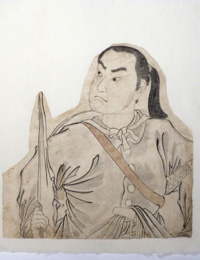
Click here to view image full size.
Utagawa KUNIYOSHI ( 1797-1861 )
Click here to view image full size.
An original shita-e drawing illustrating the play Sumidagawa Tsui no Kagamon performed at the Ichimura-za from the 3rd of the 3rd month, 1852. The drawing has the date seal for the 2nd month, 1852. From the right it shows Sawamura Chojuro V as Suzuki Mondo; Bando Shuka I as Shiraito of the Hashimoto-ya; an unidentified actor as the clerk Zenroku; an unidentified child actor as the daughter Oyone; and Onoe Kikujiro II as Mondo’s wife Oyaso. There is also a diagonal inscription on centre and right sheets that does not seem to have any bearing on the design. Publisher’s seal Iseya Chu…, of Shiba, Shimmeimaye. Centre sheet also has Kuniyoshi’s red Kiri seal. Laid onto Japanese paper. In good condition. Sold “as is.” Rare: I am not sure if this was ever made into a print. Signed Ichiyusai Kuniyoshi ga.
Status: Sold
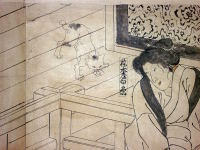
Click here to view image full size.
Keisai EISEN ( 1790-1848 )
Click here to view image full size.
A fine original shita-e for the Bijin Tokaido which compares beauties to the Fifty-three Stations of the Tokaido, this being Minakuchi, famous for kampyo, dried gourd shavings. The set was published by Tsutaya, c early 1830s but only 40 designs are known as the government considered them a little risqué. ( The reason this design has survived. ) The set was reissued without the Station numbers and censor seal for 1846. I have not seen another such Eisen drawing. Extremely rare. Signed Keisai Eisen ga.
Status: Sold
Kitagawa UTAMARO ( 1753-1806 )
Click here to view image full size.
A young mother carrying a child on her back from a set of twelve prints Meisho fukei bijin juniso, “Twelve Beautiful Women Compared to Famous Places.” A scroll-shaped cartouche top left which was probably intended to have details of the view. However, for whatever reason, these sub-titles were removed or not printed: I have only located two designs with these descriptions. Shibui illustrates eight prints from the set, p. 119. Published c 1804, although no publisher given.
Fine impression and colour. Slight soil running down right edge, otherwise very good condition. Signed Utamaro hitsu.
Status: Sold
Kitagawa UTAMARO ( 1753-1806 )
Click here to view image full size.
An extremely rare naga-oban showing the lovers Umegawa and Chubei. The courtesan Umegawa, while tying her obi, teases Kameya Chubei with the end. He reclines beneath her looking up with admiration. The couple eloped to his native village of Ninokuchi in Yamato Province. From a set of famous lovers from Joruri plays. Published by Maruya Jimpachi, c 1800. Another ( faded ) impression from the Fitzwilliam Museum is illustrated in The Passionate Art of Kitagawa Utamaro. Asano and Clark, BM, 1995, no. 335.
Fine impression. Very good colour and condition. A beautiful print. Signed Utamaro hitsu.
Status: Sold
Utagawa KUNISADA II ( 1823-1880 )
Click here to view image full size.
An original shita-e drawing showing a high-ranking courtesan parading below cherry blossom on Yoshiwara’s great central avenue ( Nakanocho ). From a set “Superior Women Today.” The publisher’s name is blacked out but it has the censor seal for 1861. In good condition. Sold “as is.” Rare. Signed Kunisada ga.
Status: Sold
Kitagawa UTAMARO (1753-1806)
Click here to view image full size.
3 vols. complete Ehon warai jogo, “The Laughing Drinker.” Published c.1803. This – probably Utamaro’s last erotic book – was issued in colour and, as here, in monochrome. According to Hayashi the two were published simultaneously, but with the black and white edition from separate blocks and an additional black block for the hair. Later recut editions are known.
Fine impressions. Minimal soil. Slight margin wormage at end of first volume and a little wormage at beginning of last volume. Nice original hand painted covers and original title slips. In chitsu case. A very nice copy of this well known book.
Status: Sold
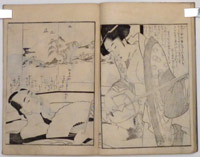
Click here to view image full size.
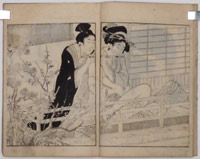
Click here to view image full size.
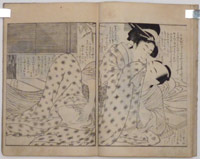
Click here to view image full size.
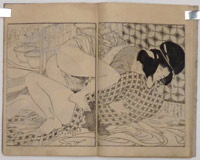
Click here to view image full size.
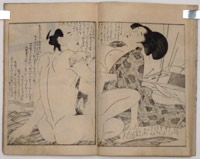
Click here to view image full size.
Kitagawa UTAMARO (1753-1806)
Click here to view image full size.
Mishima, Province of Settsu ( or Toi ) from a set of Six Crystal ( Tama ) Rivers, Furyu mu tamagawa. The streams were noted for the purity of their water and the three girls are shown fulling cloth ( hence Toi which is the alternative name of the river and the word for beating cloth ). Published by Izumiya Ichibei, c.1803-4. This appears to be from a set – like others of Utamaro’s – that could be viewed separately or as a continuous composition. See Yoshida, Utamaro zenshu, p. 173 for another design from the set. Rare.
Fine impression and colour. Full size. One minor mark, otherwise very good condition. Signed Utamaro fude.
Status: Sold
Katsukawa SHUNEI (1762-1819)
Click here to view image full size.
Iwai Hanshiro IV in a shibaraku role, probably as Akita Jonosuke Yoshikage from the play Mieiko nori no hachi no ki performed at the Kawarazaki Theatre in the 11th month, 1791. Published by Harimaya Shinshichi. Ex Beres collection, sold Paris 2002, lot 39.
Fine impression; very good colour. Slight edge thinning and very small nick out of top margin, otherwise very good condition. Signed Shunei ga.
Status: Sold
Utagawa HIROSHIGE (1797-1858)
Click here to view image full size.
An original preparatory drawing for an unpublished set: Toto Fujimi junigatsu, “Mount Fuji Viewed from the Eastern Capital Through the Twelve Months”, this being Mutsuki. Sumi on paper, c. 1850-55, 9.5 x 13.75 in; 24.5 x 35 cms. Shows a full ferry crossing the Sumida. Slight soil and centrefold, but generally very good condition. Ex collection Beres, sold Paris 2002, lot 182.
Status: Sold
Kikugawa EIZAN (1787-1867)
Click here to view image full size.
An early Eizan published c. 1810s by Shimizu. Seiro Niwaka zensei ki, “Popular Entertainment at the Niwaka Festival.” Aizuga yanagi koshizuki, with a list of entertainers. This event during the 8th month of every year in the Edo Yoshiwara involved dancing and music and girls dressed – as here, lower right figure – as men.
Superb impression and colour’ Slight browning of the thick hosho and small nick out of top left edge, otherwise very good condition. Full size. Signed Eizan hitsu.
Status: Sold
Utagawa TOYOKUNI I (1769-1825)
Click here to view image full size.
The actors Otani Tomoemon II as Iwaki Yagenji and Bando Mitsugoro II as Wakato Tomoji in the play Tsuki wa Musashino aki no sewa goto performed at the Kiriza theatre, 7/1797. One of Toyokuni’s best double bust portraits. Published by Moriya Jihei 1797. Ex Hayashi collection ( seal top left ).
Fine impression. Very good colour. Very slight centre fold and one small wormhole. Signed Toyokuni ga.
Status: Sold
Katsukawa SHUNSHO (1726-1792)
Click here to view image full size.
The actor Ichikawa Danjuro V as Kajiwara Genta. Published c early 1780s. Illustrated in T.N.M.C. vol.1, no. 1051. A night scene. The actor deploys an umbrella and holds a lantern with the other hand. Not listed by Gookin.
Very good impression and colour. Some oxidation. Signed Shunsho ga.
Status: Sold
Toyohara KUNICHIKA ( 1835-1900 )
Click here to view image full size.
A vertical diptych showing the actor Onoe Kikugoro V in the role of Komamonoya Saijiro, “Saijiro of the haberdashery store,” fighting a giant serpent in the play Inaba Kozo ame no yobanashi performed at the Nakamura-za theatre in 11/1887. Published by Fukuda Kumajiro in 1887. Evidently the actor was swallowed whole during this scene ! An extremely rare print.
Fine impression and colour. Extensive mica on the serpent’s head and body. This is the only impression of this design I have seen retaining the publication details in the left margin ( albeit even here slightly trimmed ). Very good condition. Ample margin for joining the two sheets. Signed Oju Toyohara Kunichika hitsu.
Status: Sold
Utagawa KUNISADA ( 1786-1864 )
Click here to view image full size.
An uncut fan print showing a bust portrait of the actor Nakamura Shikan II as Matsuomaru in the scene Kuruma-biki from the play Sugawara denju tenari kagami, “Sugawara’s Secrets of Calligraphy” performed at the Nakamura-za theatre, 5/1832. This episode gives rise to one of Kabuki’s most celebrated scenes involving Matsuomaru’s two brothers and the carriage of Shihei. Extremely rare. Published 1832. Publisher not identified.
Very good impression and colour. Slight vertical crease and small edge wormage at top, otherwise good condition. Signed Gototei Kunisada ga.
Status: Sold
Utagawa KUNISADA ( 1786-1864 )
Click here to view image full size.
The actor Nakamura Shikan II as Shoki, the demon queller. One of the nine roles in the hengemono dance Kyo kokonoe yayoi no hanamichi performed at the Nakamura-za theatre, 3/1833.Shoki ( Chin: Chung K’uei ) is said to have visited the sick T’ang dynasty emperor, Ming Huang, when he was tormented by fever demons. He recovered and Shoki told the emperor he had promised to rid the country of evil to repay the respect given him by a past emperor after he committed suicide. A favourite character in Japan, he is often depicted in red to ward off evil spirits and shown fighting demons. Paintings of Shoki were hung on Boy’s Day. Published by Yamamoto Kyubei, 1833. Rare.
Very good impression and colour. Slight soil and edge crease at left edge, otherwise good condition. Signed Gototei Kunisada ga.
Status: Sold
Okumura TOSHINOBU (active c. 1717-1750)
Click here to view image full size.
A hosoban showing an interior scene with the actor Ogino Isaburo I ( 1703-48 ), seated and playing a shamisen with a plectrum. Behind him is a courtesan, one hand on the shamisen. Toshinobu may have been the adopted son of Okumura Masanobu. Published by Soshu ( Sagami ) – ya c. 1725-30.
Good impression. Nice hand colouring with beni, mustard, yellow, blue and the addition of gum and gold powder ( bronze or brass ). Slight toning and loss of gold. Unsigned.
Status: Sold
Utagawa KUNISADA (1786-1864)
Click here to view image full size.
A bust portrait of the famous quick-change actor Bando Mitsugoro III as Kajiwara Genta Kagetoki. Performed at the Ichimura-za Theatre in the 3rd month 1811 ( Bunka 8 ). From Kunisada’s finest set: Oatari kyoden no uchi, “Great Performances.” A set of seven prints of celebrated roles of the previous eight years selected from the Oatari kyogen, “Big Hits.” Sumptuously produced with mica grounds which had not been used for twenty years. The expressive poses hark back to similar prints by Toyokuni I and Kunimasa. Exceedingly rare, on a par with many Sharaku prints. Published by Fukusendo, c 1815. Another impression is in the Rietberg Museum, Zurich.
Fine impression. Slightly trimmed left side towards the top and repaired binding holes at top, otherwise good condition. Very good colour with the mica well retained. Signed Gototei Kunisada ga.
Status: Sold
Keisai EISEN (1790-1848)
Click here to view image full size.
An amorous couple prior to coitus. One of the three best designs from a set of twelve prints: Keisei higo, “Secret Words of a Courtesan” published c 1822-25. Although the set comes under the shunga heading, each print is an abuna-e design, without any graphic detail. Fine composition.
Fine impression and colour. Laid onto board from the original album. Small wormage and slight centre fold ( as usual ), otherwise good condition.
Status: Sold
Utagawa TOYOKUNI I (1769-1825)
Click here to view image full size.
A double actor portrait showing Ichikawa Yaozo III in the role of Ume no Yoshibei, and Segawa Kikunojo III as his wife Koume, in the play Zoho Ume no Yoshibei performed at the Ichimura-za Theatre in the 4th month of 1801 ( Kyoho 1 ). Published by Uemura Yohei. Toyokuni was the pupil of Utagawa Toyoharu and went on to produce some of the finest actor prints of the period.
Fine impression, colour and condition. Full size. Signed Toyokuni ga.
Status: Sold
Utagawa TOYOKUNI I (1769-1825)
Click here to view image full size.
A double actor portrait showing Arashi Hinasuke II in the role of Fuwa Banzaemon, and Segawa Kikunojo III as the lady Okuni Gozen, in the play Jujo Genji Monogusa Taro performed at the Ichimura-za Theatre in the 8th month of 1800 ( Kansei 12 ). Published by Nishimuraya Yohachi. Toyokuni was the pupil of Utagawa Toyoharu and went on to produce some of the finest actor prints of the period.
Fine impression, colour and condition. Full size. Signed Toyokuni ga.
Status: Sold
Utagawa TOYOKUNI I (1769-1825)
Click here to view image full size.
A fine double actor portrait showing Segawa Kikunojo III as Wakasa no tsubone, and Arashi Sanpachi I as Miura Danjo in the play Utsukushiya yuki no sekai, performed at the Ichimura-za Theatre in the 11th month of 1799 ( Kansei 11 ). Published by Nishimuraya Yohachi. Toyokuni was the pupil of Utagawa Toyoharu and went on to produce some of the finest actor prints of the period.
Fine impression, colour and condition. Full size. Signed Toyokuni ga.
Status: Sold
Mori KANSAI (1814-1894)
Click here to view image full size.
A highly regarded artist who practised and taught the Shijo style in Kyoto. The pupil and adopted son of Mori Tetsuzan. A fine album ( 15 x 12 in; 38.2 x 30.5 cms ) of twelve Shijo drawings in sumi and light colour on paper. The album is beautifully presented with heavily gold-flecked paper throughout and silk brocade covers, the chitsu also covered in brocade. Some light foxing giving a wabi-sabi spirit to the work. Signed and sealed Kansai on last drawing.
Status: Sold
Utagawa KUNISADA (1786-1865)
Click here to view image full size.
An early and apparently unrecorded chuban triptych showing, on first sheet, an awabi diver near Enoshima surfacing to supply a party on a balcony, far left. Published c.1810s.
Expert repairs in sky, otherwise good impression, colour and condition. Unsigned.
Status: Sold
Ichiryusai HIROSHIGE (1797-1858)
Click here to view image full size.
Oi, a suburb of present day Ena City, is in the southern foothills of the central mountain range now known as the Japan Alps. Shows a group of travellers heavily protected against the snow and cold. From Kisokaido rokujukyutsugi no uchi, “Sixty-Nine Stations of the Kisokaido.” The set of seventy prints was started by Eisen and published by Hoeido in 1835, but in 1837 Hiroshige took over and completed the series with the publisher Iseya Rihei ( Kinjudo ). One of Hiroshige’s most famous designs.
Very good impression. The earliest impressions have gradation on the Kiso range in the background and in the sky. Some versions are also known with splashed gofun. Very slight centre fold. Very good colour. Signed Hiroshige ga.
Status: Sold
Ichiryusai HIROSHIGE (1797-1858)
Click here to view image full size.
Nagakubo, one of the major designs from Kisokaido rokujukyutsugi no uchi, “Sixty-Nine Stations of the Kisokaido.” The set of seventy prints was started by Eisen and published by Hoeido in 1835, but in 1837 Hiroshige took over and completed the series with the publisher Iseya Rihei ( Kinjudo ). Shows travellers near and on the Wada Bridge over the Yodo River. As with most important compositions from the set, there are numerous states where the printers/publishers experimented with alternative wipings to alter the design: On some impressions the far mountains are not seen; on others they are graded-off to the right. The far rail on the bridge comes and goes and the blue gradation on the river varies. The earliest state appears to omit the mountains and have bokashi around the moon. ( Late editions also omit the mountains. )
Very good early impression with extra bokashi across the moon. Remargined on the two vertical sides, otherwise very good condition. Very good colour. Signed Hiroshige ga.
Status: Sold
Tsukioka YOSHITOSHI (1839-1892)
Click here to view image full size.
An original preparatory drawing ( hanshita-e ) for an unrecorded and unpublished oban set of Twenty-four Paragons of Filial Piety. The stories originated in China where filial piety is considered the first virtue ( being common to almost all religions in China ). This drawing obviously depicts Kokaku ( Chinese: Chiang Ko or Jiang Ge ) who carried his mother on his back to escape civil war in their village. Sumi and light brown under-drawing on thin paper. Sold “as is” with some creasing and wormage. Signed Yoshitoshi ( signature c 1887-91 ). Ex collection Mizuno Toshikata
Status: Sold
Mizuno TOSHIKATA (1866-1908)
Click here to view image full size.
A collection of approx. 36 drawings by and from the collection of Mizuno Toshikata. (Four pages shown. ) Bound with paper string on thin paper, sumi and red ink. Cover with Toshikata seal. Various historical, domestic and social subjects. An interesting study group by Yoshitoshi’s best pupil ( who later studied with Watanabe Shotei ). Album size: 10 x 13.5 in; 25.5 x 34.25 cms. The drawings in various sizes but no larger than the album. Generally good condition.
Status: Sold
Ichiryusai HIROSHIGE (1797-1858) ET AL
Click here to view image full size.
Four volumes ( vols 5, 6, 8, 10 ) Ehon miyage, “Souvenirs from Edo.” The series of ten volumes was published between 1850 ( vol 1 ) to 1867 ( vol 10 ). Originally intended to be four volumes, the other books were gradually added. Volume 8 has a preface stating that Hiroshige had passed away but that he had left enough drawings to continue the series. Volume 10 was designed by Hiroshige II. Very clean good impressions with original covers and title slips. One hole on volume 6, otherwise very good condition. Each book also has the original paper slip-cases sewn on ( rare ). These have saved the covers and especially the title slips which are almost mint. Publisher Kinkodo, Kikuya Kozaburo, 1850 – 67.
Status: Sold
Ogata GEKKO (1859-1920)
Click here to view image full size.
The original preparatory drawing for a triptych published by Matsuki Heikichi, 1898, showing Tadanobu ( one of Yoshitsune’s men ) fighting the priest Yokogawa Kakuhan in Yoshinoyama. Sumi and light red on thin paper, each sheet 15 x 10.5 in; 38 x 26.5 cms. First sheet signed Gekko. Extremely good condition. Ex collection Mizuno Toshikata ( the artist, 1866 – 1908 ).
Status: Sold
Ogata GEKKO (1859-1920)
Click here to view image full size.
A large cartoon, sumi on thin paper folding out to 25.5 x 42 in; 65 x 106.5 cms. The subject is the Last Stand of the Kusanoki Clan. In fact Gekko designed a triptych of this subject in 1890 which is very similar to this large drawing. Why he made this large version is not known: Perhaps he was intending to make a painting or he just liked the subject. Very good condition. Ex collection Mizuno Toshikata ( the artist, 1866 – 1908 ).
Status: Sold
Tsukioka YOSHITOSHI (1839-1892)
Click here to view image full size.
Looking Itchy: The Appearance of a Kept Woman of the Kaei Era ( 1848 – 1854 ). From the set: Thirty-two Aspects of Women published by Tsunashima Kamekichi, 1888. Shows a dishabille beauty emerging from a mosquito net. One of the two or three best designs from the set.
Fine impression of the first edition. Fine colour and condition with the extra paper at left edge and the full handling area showing bottom right. Signed Yoshitoshi ga.
Status: Sold
Ichiryusai HIROSHIGE (1797-1858)
Click here to view image full size.
Shionada from Kisokaido rokujukyutsugi no uchi, “Sixty-nine Stations of the Kisokaido.” The set of seventy prints was started by Eisen and published by Hoeido in 1835, but in 1837 Hiroshige took over and completed the series with the publisher Iseya Rihei (Kinjudo). Shows boatmen and river porters in the early morning waiting for trade on the banks of the Chikuma River. The river was broad here and the ferry did not always cross. The porters would be engaged to take travellers across on platforms or even on their backs.
Fine and extremely early impression. The corner of the publisher’s seal always shows broken off, even on the earliest impressions. Fine colour. Left border trimmed, otherwise fine condition. Signed Hiroshige ga.
Status: Sold
Torii KIYOTSUNE (active 1757-1779)
Click here to view image full size.
Little is known of the artist’s life except that he was a pupil of Kiyomitsu. Shows the actor Bando Hikosaburo II as Watanabe no Tsuna and Nakamura Tomijuro as Ibaraki. This famous story recounts how Watanabe no Tsuna cuts off the arm of the demon Ibaraki at the Rashomon Gate, Kyoto in 976. He secretes the arm away in a box. Subsequently he is visited by his wet-nurse ( or aunt – depending on which version you read ) who convinces him to show it to her. Instantly she snatches the arm and flies off revealing herself to be Ibaraki in disguise. The story became the famous no play Ibaraki. Published by Bakuro-cho ichome, Yamashiro han, c. late 1760s.
Fine impression. Pristine condition. The fugitive dyes perfectly retained. In the same condition as the day it was printed. Signed Torii Kiyotsune fude.
Status: Sold
Utagawa KUNISADA (1786-1864)
Click here to view image full size.
A bust portrait of the famous onnagata actor Iwai Hanshiro V in the machi musume, “town maiden” role of Oshichi. A greengrocer’s daughter, she burned down most of Edo in order to be with her lover Kichisaburo. He first performed the role at the Morita-za Theatre in 3/1809 in Sono mukashi koi no edozome. From Kunisada’s finest set: Oatari kyoden no uchi, “Great Performances.” A set of seven prints of celebrated roles of the previous eight years selected from the Oatari kyogen, “Big Hits.” Sumptuously produced with mica grounds which had not been used for twenty years. The expressive poses hark back to similar prints by Toyokuni I and Kunimasa. Exceedingly rare, on a par with many Sharaku prints. Published by Fukusendo, c 1815. Other impressions in the Rijksmuseum, Amsterdam ( 1956:667 ) and illustrated in Ukiyoe Taikei, vol. 10, no. 146, p. 99.
Fine impression. Completely untrimmed. Very good colour with the purple intact and only slight turning at the edge. Slight loss of mica ( as usual ) and minor soil, otherwise very good condition. Signed Gototei Kunisada ga.
Status: Sold
